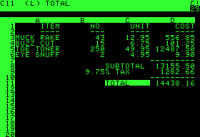 VisiCalc var det første regnearksprogram tilgængeligt for personal computers. It is often considered the application that turned the microcomputer from a hobby for computer enthusiasts into a serious business tool. VisiCalc sold over 700,000 copies in six years.1))
VisiCalc var det første regnearksprogram tilgængeligt for personal computers. It is often considered the application that turned the microcomputer from a hobby for computer enthusiasts into a serious business tool. VisiCalc sold over 700,000 copies in six years.1))
Origins
Conceived by Dan Bricklin, refined by Bob Frankston, developed by their company Software Arts<ref name=„tomcalc“> last =Hormby | first =Thomas | authorlink = | coauthors = | title =VisiCalc and the rise of the Apple II | work = | publisher =[[Low End Mac]] | date =2006-09-22 | url =http://lowendmac.com/orchard/06/0922.html | doi = | accessdate =2007-03-02 </ref>, and distributed by Personal Software in 1979 (later named VisiCorp) for the Apple II computer, it propelled the Apple from being a hobbyist's toy to being a much-desired, useful financial tool for business<ref name=„tomcalc“/>. At the time, most microcomputers suffered from lack of storage space and display limitations that made them poor competitors especially in the database markets.date=June 2008 The spreadsheet, however, did not depend on powerful displays or storage media and so was an ideal fit for microcomputer technology available at the time.date=June 2008 This likely motivated IBM to enter the PC market which they had been ignoring. After the Apple II version, VisiCalc was also released for the Atari 8-bit family, the Commodore PET, TRS-80, and the IBM PC<ref name=„tomcalc“/>.
According to Bricklin, he was watching a professor at Harvard Business School create a financial model on a blackboard. When the professor found an error or wanted to change a parameter, he had to erase and rewrite a number of sequential entries in the table. Bricklin realized that he could replicate the process on a computer using an „electronic spreadsheet“ to view results of underlying formulae<ref name=„joshcalc“> last =Coventry | first =Joshua | authorlink = | coauthors = | title =Interview with Dan Bricklin, Inventor of the Electronic Spreadsheet | work = | publisher =[[Low End Mac]] | date =2006-11-02 | url =http://lowendmac.com/coventry/06/1107.html | doi = | accessdate =2007-03-02 </ref>.
Successors
Charles Babcock of InformationWeek argues that in retrospect, „VisiCalc was flawed and clunky, and couldn't do many things users wanted it to do.“<ref>[http://www.techweb.com/article/showArticle.jhtml?articleId=191901844&pgno=1 What's The Greatest Software Ever Written? - Technology News by TechWeb<!– Bot generated title –>]</ref> Soon, more powerful clones of VisiCalc were released, including SuperCalc (1980), Microsoft's MultiPlan (1982), Lotus 1-2-3 (1983), and the spreadsheet module in AppleWorks (1984). With Microsoft Excel (introduced for the Macintosh in 1985 and for Windows 2.0 in 1987), a new generation of spreadsheets was born.
Spreadsheets were a prominent enough idea that a spreadsheet program was shipped as C source code as an example of Borland's Turbo C compiler.
Reception
Antic reviewer Joseph Kattan wrote „VisiCalc isn't as easy to use as prepackaged home accounting programs, because you're required to design both the layout and the formulas used by the program. Because it is not pre-packaged, however, it's infinitely more powerful and flexible than such programs. You can use VisiCalc to balance your checkbook, keep track of credit card purchases, calculate your net worth, do your taxes - the possibilities are practically limitless.“<ref name=„8-Bit Product Reviews: VISICALC“>[http://www.atarimagazines.com/v3n2/productreviews.html?tag= 8-Bit Product Reviews: VISICALC]</ref>
See also
- Triumph of the Nerds, A documentary hosted by Robert X. Cringely that featured the creators of VisiCalc and their contribution as the first killer app for the personal computer.
References
External links
- [http://www.danbricklin.com/visicalc.htm Dan Bricklin's Own VisiCalc Website] – With history information as well as downloadable PC version
- [http://www.frankston.com/?name=ImplementingVisiCalc
Implementing VisiCalc] – By Bob Frankston, on his website - [http://www.pcworld.com/resource/printable/article/0,aid,116166,00.asp Three Minutes: Godfathers Of The Spreadsheet] –
PC World interview with the creators of VisiCalc - [http://techdirt.com/articles/20050812/1835229_F.shtml Techdirt: What If VisiCalc Had Been Patented?]
- [http://www.trs-80.org/visicalc/ TRS-80 and more]
Secrets of Software Success: Management Insights from 100 Software Firms Around the World, ISBN 1578511054 (1999